In the fast-moving digital world, it is very important for any business to stay at the top of the search rankings.
Solid SEO automation is important for the attraction of organic traffic and making a business popular online.
As SEO gets more complex, however, it may indeed be very difficult to keep track of all this manually.
That is the point when automation will enter into the SEO area, which leads to changing our perception towards digital marketing.
Businesses can save time and increase efficiency and accuracy by automating repetitive SEO processes.
In this article, we’re going to dive deep into how SEO automation can deliver fantastic results and give great insight into how you could automate your way of working in 2024!
- What You Need to Know About SEO Automation
- SEO Automation Tools to Snatch: Your Investment for Efficiency
- Automation of SEO Tasks: How to Automate Step by Step
- Advanced SEO Automation Strategies for 2024
- PRO Tip: Measuring Success; Evaluating the Impact of SEO Automation
- Conclusion: How to Release the Full Power of SEO Automation
- FAQs About SEO Automation
What You Need to Know About SEO Automation
Anything that enables us to get the work done without getting our hands dirty is called SEO automation.
It makes the SEO process much easier by removing redundant and boring activities from your hands, leaving you to focus on strategies that bring results.
SEO automation tools can help you with everything—from optimizing content to keyword data analysis and rank tracking, you can automate repetitive tasks across all these efforts.
Well, what is the relevance of SEO automation?
Since SEO is growing and consistently evolving, it’s becoming more data-driven yet labor-intensive.
Instead of trying to keep track of hundreds or thousands of keywords, updating meta tagsHTML tags that provide metadata about a webpage, such as descriptions and keywords., or creating backlinksLinks from other websites pointing to your site, essential for SEO ranking. manually, it’s simply not a scalable effort.
Automation now comes to save you by enabling you to handle great volumes of data with ease and complete accuracy.

A clear depiction of SEO automation processes through interconnected gears and graphs, symbolizing the continuous flow of automated tasks.
Defining SEO Automation
With SEO automation, you will be carrying out basic tasks, such as keyword tracking and rank analysis through SEO reporting or automating content optimization, by using technology.
These tools can include algorithms and AI to highlight insights and recommendations, so that data-driven decisions become clear.
Applying these tools to your SEO strategy will give you the means to automate and quickly optimize your website for search engines.

A visual representation of the critical role SEO automation plays in improving efficiency and accuracy through automated processes.
Why Automation of SEO Is Important
Automation in SEO is not just becoming a trend; rather, it is becoming an increasing need.
With Google and other search engines updating algorithms more frequently, keeping up with these changes manually is almost unimaginable.
SEO automation keeps you updated with all these changes without having to monitor your site performance all the time.
It makes you more process-conscious, providing real-time feedback on what’s working and what is not.
In the long run, this will increase rankings, traffic, and user experience (UX).

A visual comparison of SEO automation, symbolizing speed and efficiency, against manual SEO, representing labor-intensive and slower processes.
SEO Automation vs. Manual SEO
Manual SEO definitely has its advantages, but it is a tedious and time-consuming process.
Manual tasks like keyword research, link building, and meta tag optimization can easily fill up your days.
In contrast, SEO automation tools get all these things done in a fraction of the time.
The time saved by automating mundane tasks can be spent on strategic thinking or creative efforts, giving your business a real edge.

A visual representation of the key benefits businesses gain from SEO automation, highlighting efficiency, scalability, and time-saving.
Key Benefits of SEO Automation for Businesses
- Save Time: Tasks that normally require hours for completion can be completed in no time using SEO automation software.
- Scalability: As your business grows, so does your SEO workload. SEO automation enables you to scale without overwhelming your team.
- Greater Accuracy: Humans are prone to errors, especially when processing large volumes of data. Automation reduces the risk of errors and improves SEO best practices.
- Cost-Effectiveness: Automating SEO practices means businesses don’t have to pay for manual labor, reducing operational costs.
SEO automation removes repetitive tasks, allowing businesses to focus on growth and strategy implementation.

A visual showcasing essential SEO automation tools, highlighting their role in improving efficiency and performance.
SEO Automation Tools to Snatch: Your Investment for Efficiency
With the rise of SEO automation, companies have more tools than ever to make the most of organic search campaigns.
These tools save time and provide greater accuracy for any SEO strategy.
Picking the right automation tools can make a huge impact on how effectively you oversee your SEO campaigns.
In this section, I’ll share some popular and powerful SEO automation tools that help you get things done a lot faster.
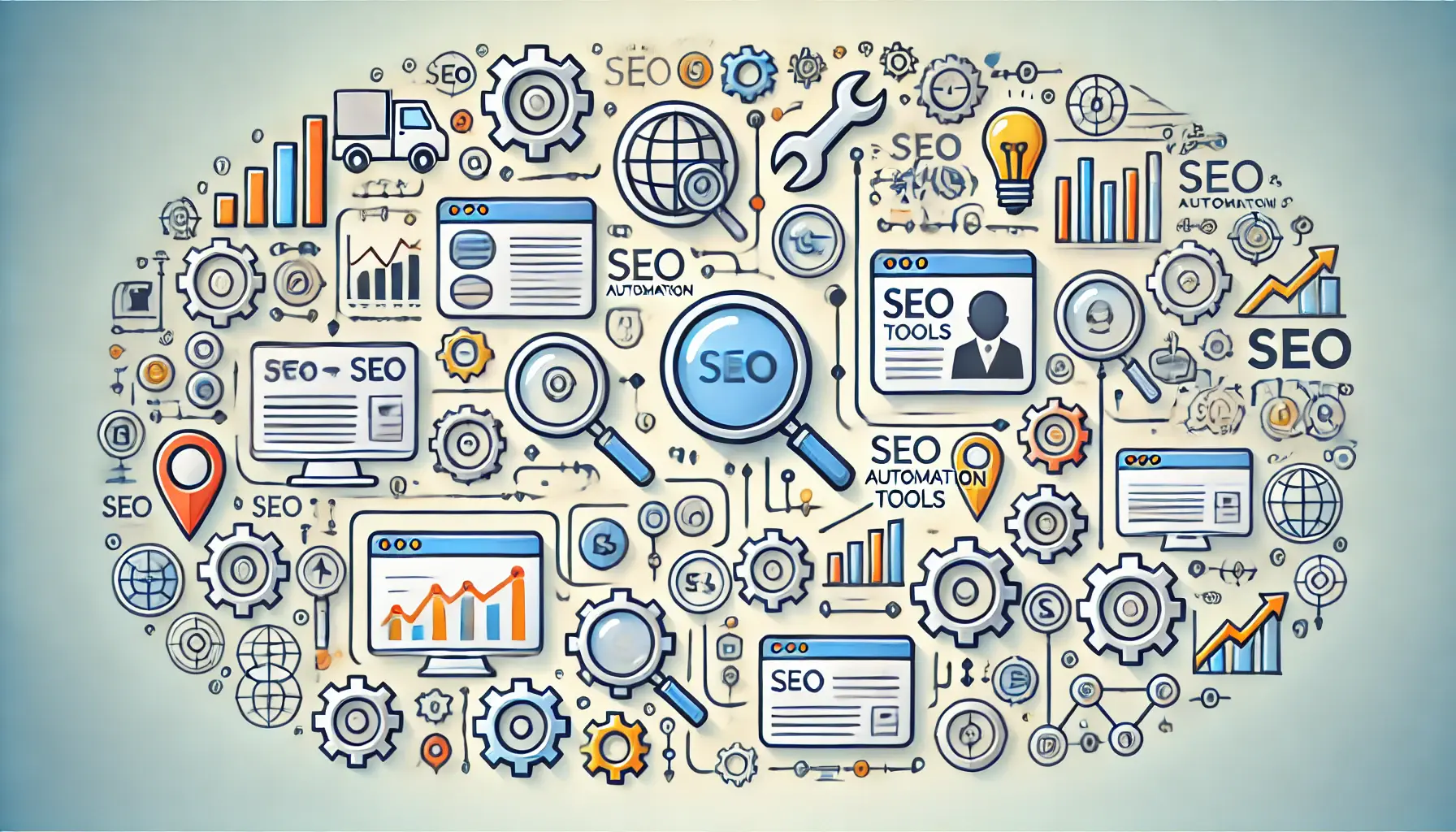
An overview of the most common SEO automation tools, symbolized by interconnected gears, graphs, and dashboards.
Most Common SEO Automation Tools with Overview
There are several tools that work really well in automating SEO-based tasks.
From keyword research to technical SEO audits, these tools have got your back.
Here are some of the best SEO automation tools to consider:
- SEMrush: A full-suite competitive intelligence toolbox offering keyword research, rank tracking, and backlink analysis. It also provides automation services for SEO reports and content optimization recommendations.
- Ahrefs: Known for its excellent backlink checker and keyword research tools, Ahrefs can automatically handle much of the link-building and competitive analysis work for you.
- Google Search Console: While not fully automated by itself, integrating it with proper automation platforms allows for faster tracking of site performance and catching problems swiftly.
- Surfer SEO: This tool automates content optimization by analyzing top-ranking pages and recommending which keywords to include, the ideal structure, and the number of words.
- Screaming Frog: A technical SEO tool that automates website crawling to identify broken links, redirects, and other issues that could be affecting your search engine rankings.
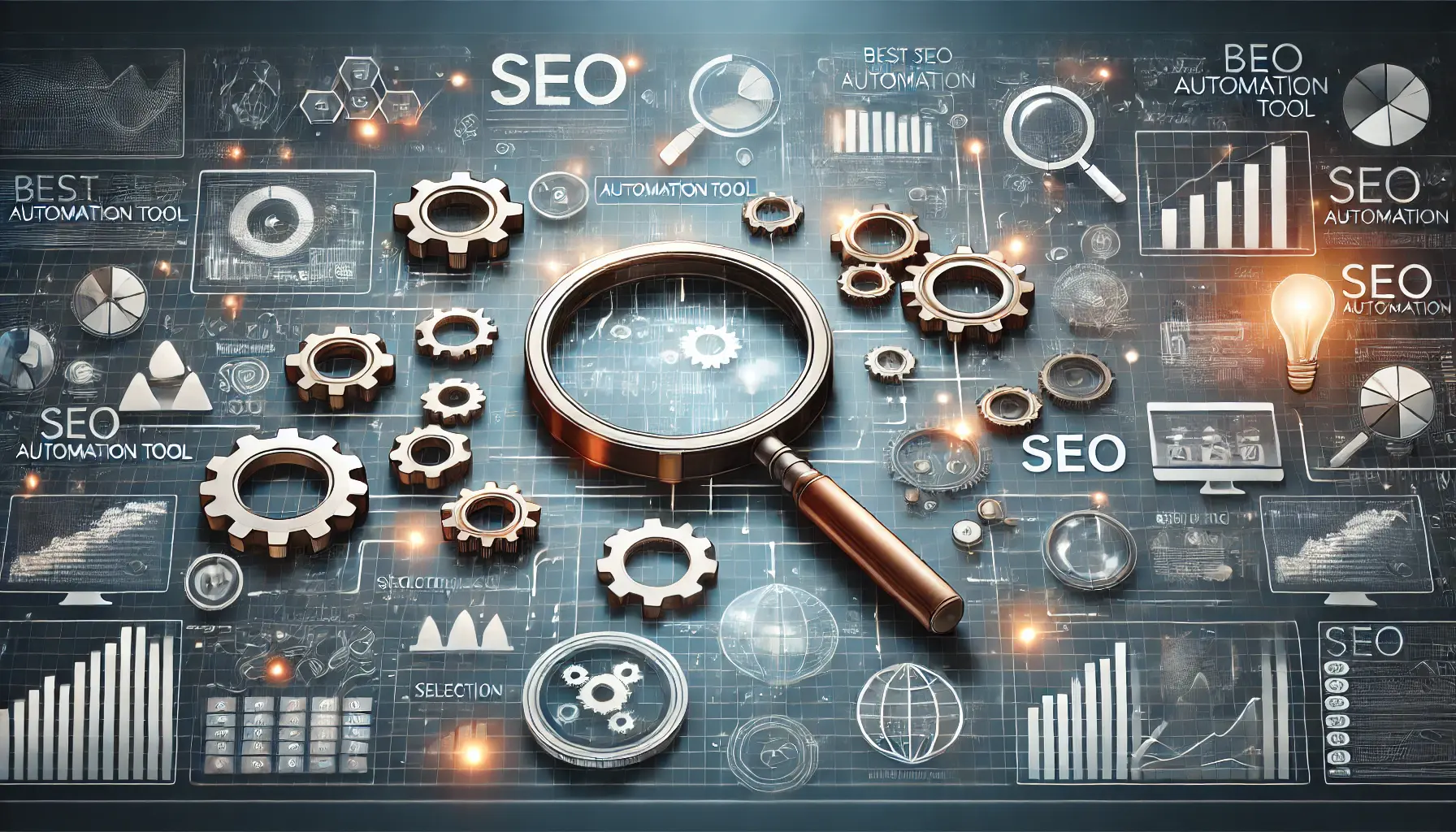
A visual representation of the process of selecting the best SEO automation tool for a business, highlighting the decision-making involved.
Selecting the Best Automation Tool for Your Business
The right SEO automation tool depends on your business’s specific needs and goals.
Consider the following factors when choosing the best tool:
- Business Size: Some tools are designed for large enterprises, while others are more suited for small businesses or startups.
- Task Review: Determine which SEO tasks can be automated, such as content optimization, keyword tracking, or link building.
- Pricing: SEO automation tools come with various pricing plans. Choose one that fits your budget while meeting your SEO needs.
- Ease of Use: Look for a tool that is user-friendly and easy to integrate into your workflow. This saves time and reduces the learning curve for your team.

A visual representation of how different SEO automation tools integrate to form a cohesive and connected system.
SEO Automation Tool Integration: What to Use and Where
Incorporating SEO automation tools into your existing SEO workflow requires careful planning.
Follow these steps for a smooth transition:
- SEO Process Audit: Identify areas of your SEO strategy that would benefit the most from automation.
- Start Small: Begin by automating simpler tasks like keyword tracking or technical audits before moving on to more complex processes.
- Set Clear Objectives: Define your goals for using SEO automation tools and monitor their performance through analytics to adjust your strategy as needed.
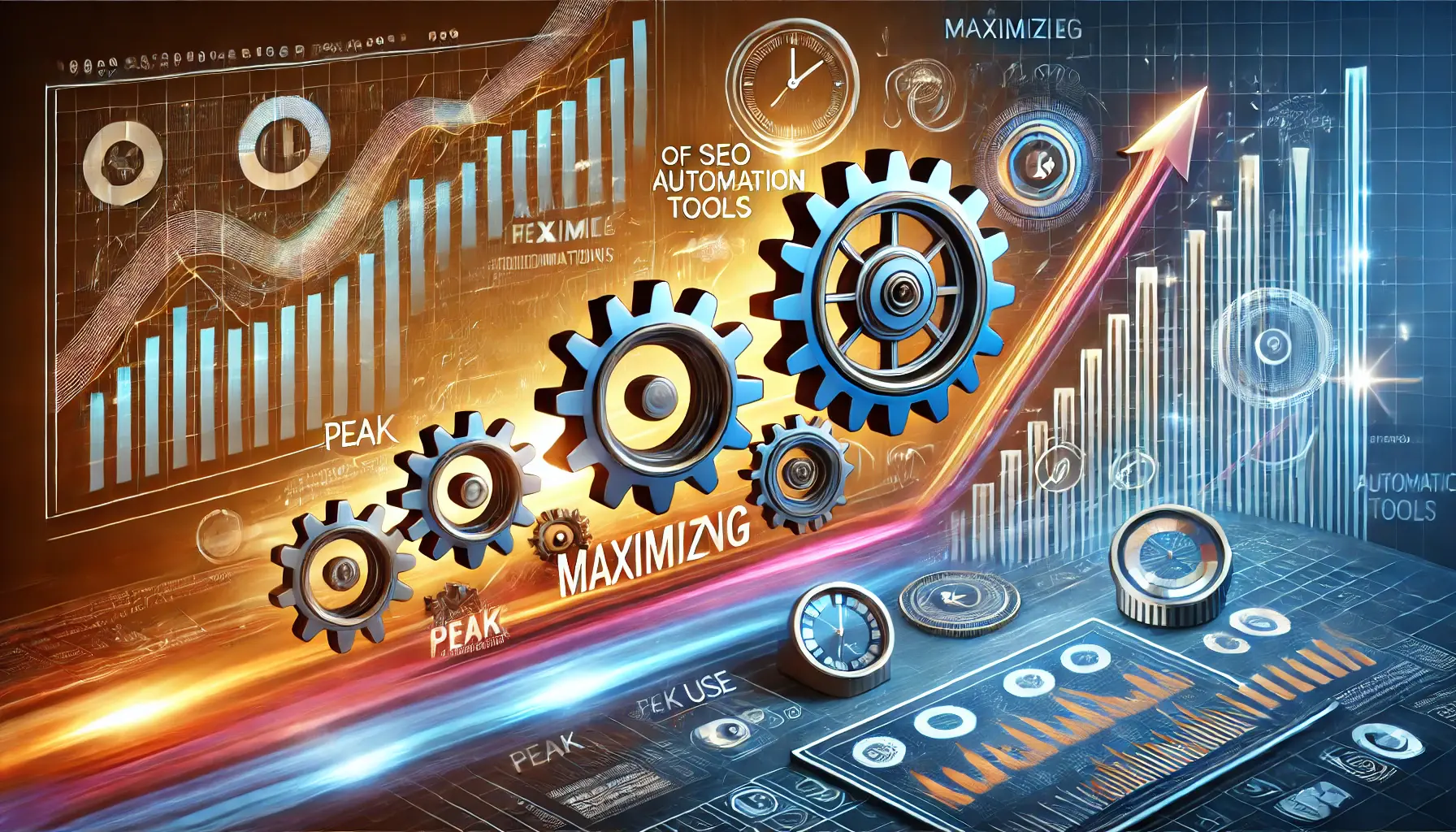
A visual showing the maximum efficiency and performance of SEO automation tools, symbolized by gears, graphs, and dashboards running at peak levels.
Maximizing the Use of SEO Automation Tools
If you’re planning to use SEO automation tools, it’s essential to get the most out of them.
Here are a few tips:
- Keep Tools Updated: Regularly update your automation tools to stay current with the latest data and features.
- Combine Tools: Using multiple tools together often creates a more comprehensive SEO strategy. For example, pairing SEMrush for keyword research with Screaming Frog for technical audits gives you a deeper insight into your site’s performance.
- Automate Reporting: Set up automated SEO reporting systems to track KPIs without having to manually collect data.
- Stay Involved: While automation saves time, regular monitoring and adjustments are necessary to keep your SEO efforts on track.
Choosing the right automation tools depends on your specific SEO needs, from keyword research to content optimization.
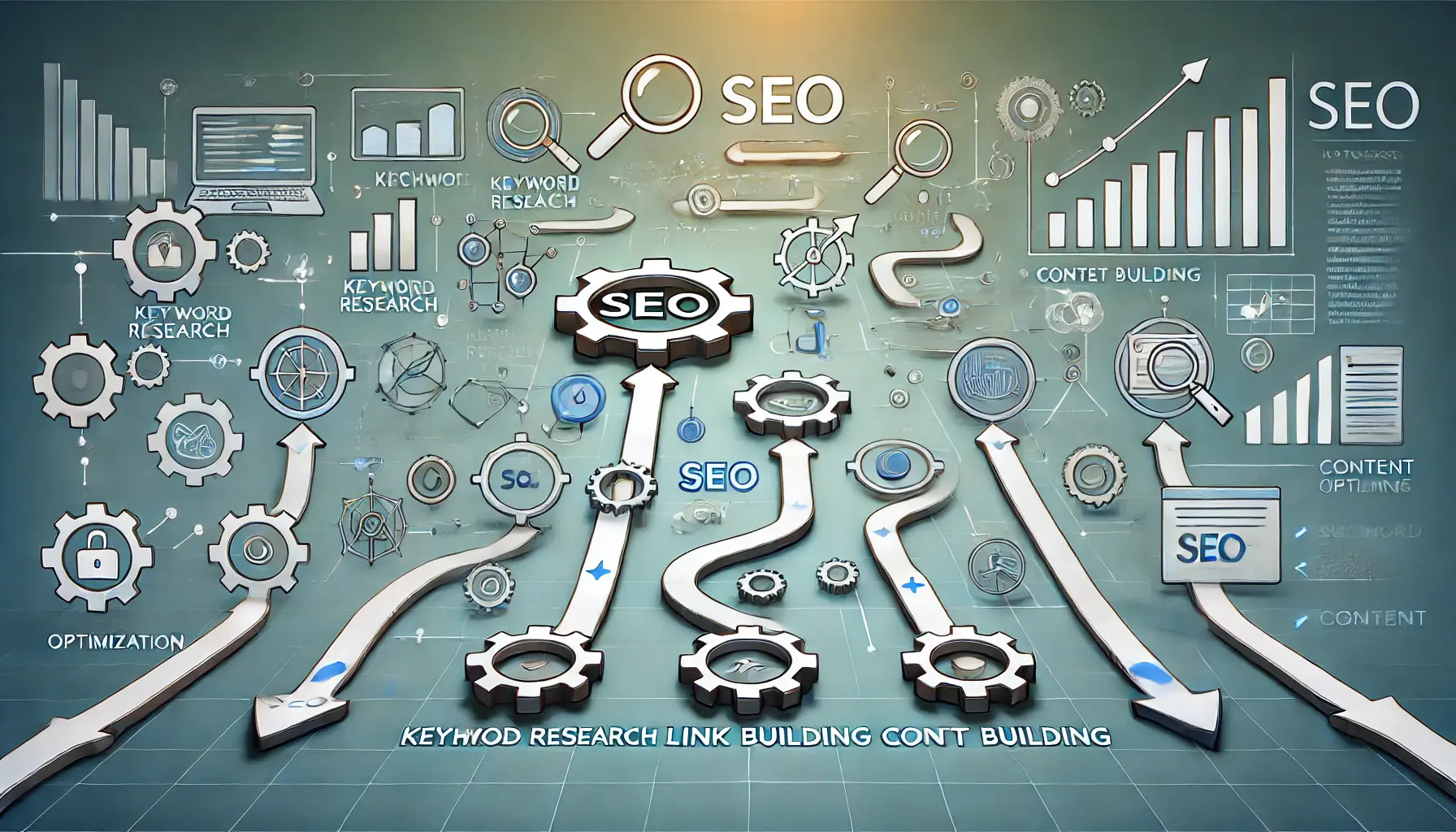
A visual representation of the step-by-step automation of SEO tasks, showcasing the flow of processes from keyword research to optimization.
Automation of SEO Tasks: How to Automate Step by Step
With an overview of some good SEO automation tools available, let’s move into specific task automation in SEO.
Using automation features in those tools will save you hours of manual effort and increase the accuracy of tasks, allowing you to invest time in higher-impact tasks such as strategy development and analysis.
In this all-inclusive step-by-step SEO automation guide, learn how to automate several components of your search engine optimization process and improve your everyday efficiency.
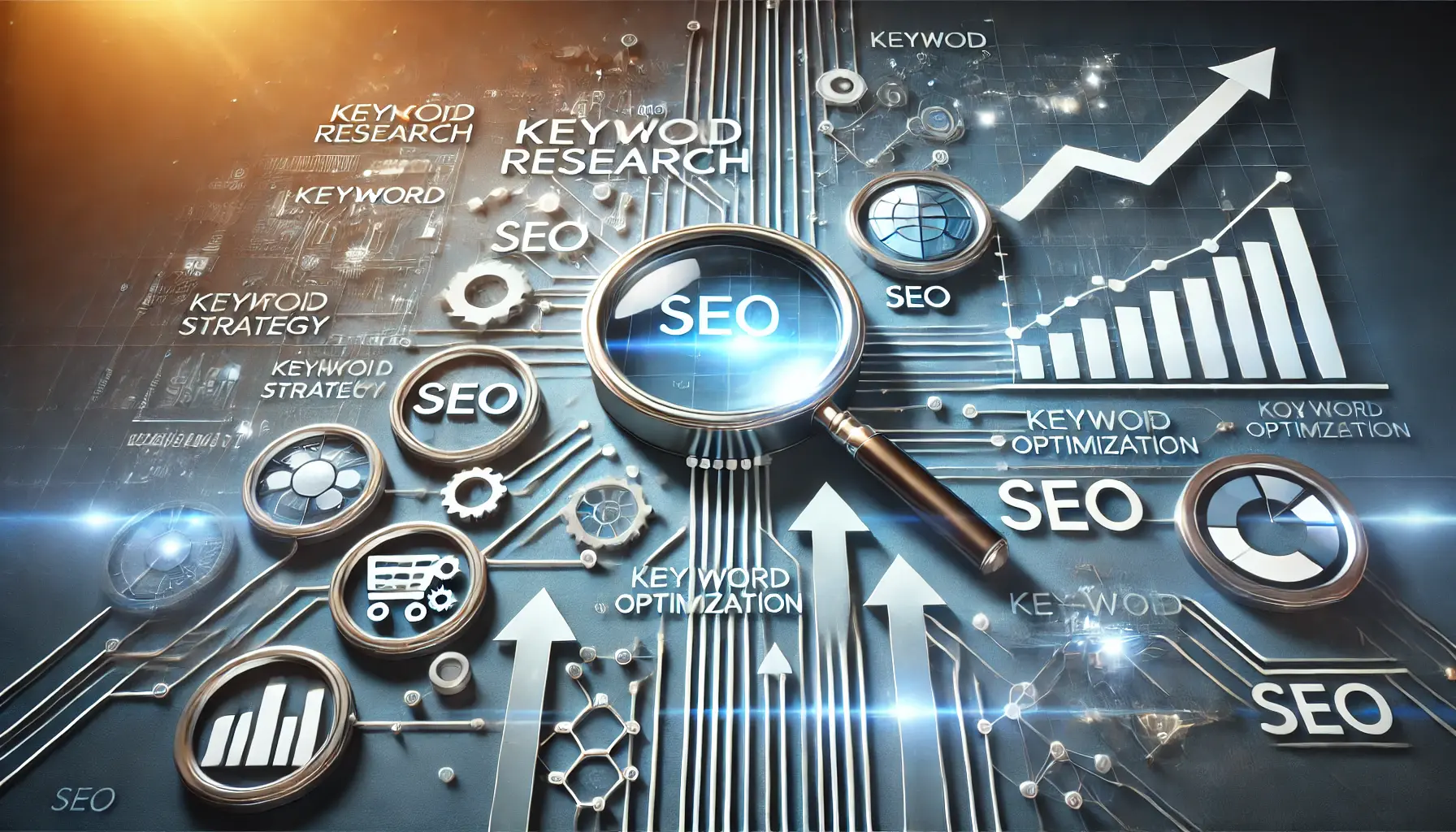
A visual representation of the keyword research and optimization process, highlighting the refinement and improvement of keyword strategies.
Keyword Research and Optimization
Keyword research is one of the most basic elements of an SEO strategy.
It’s used to create a list of phrases that you want your website to rank for in search engines.
However, it can be a tedious process.
SEO automation collects keyword data, increasing processing speed and allowing you to focus on implementation.
Here are the steps to automate keyword research:
- Automated Keyword Suggestions: Use tools like SEMrush, Ahrefs, and Moz to get a list of keywords broken down by search volume opportunities and ranking difficulty.
- Enable Keyword Trend Alerts: Some tools allow you to receive alerts based on keyword trends, helping you stay updated with the latest search terms in your industry.
- Automated Rank Tracking: Once you’ve identified target keywords, automate rank tracking to improve your strategy based on performance.
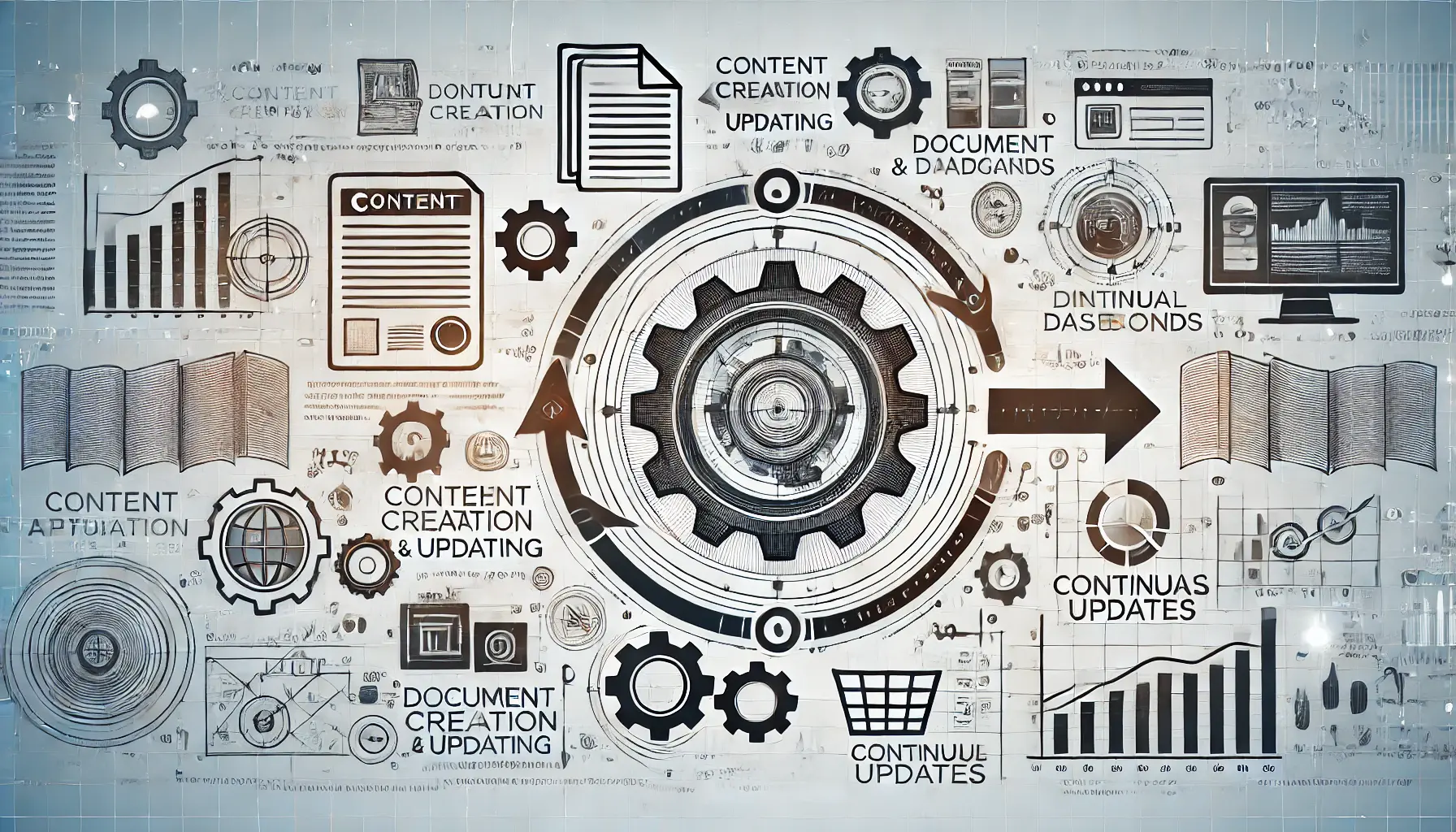
A visual representation of automated content creation and updating, showcasing gears and digital dashboards for continuous optimization.
Automating Content Creation and Updating
While content creation may never be fully automatable, there are ways to streamline the process.
Automation can help with everything from optimizing existing content to generating new ideas:
- Content Optimization Automation: Tools like Surfer SEO and Clearscope suggest content optimizations to better align your content with what is ranking in the search results.
- Automatic Content Refresh: Tools are available to monitor content performance and recommend updates or refreshes to improve SEO rankings.
- AI-Powered Content Generation: AI tools like Jasper and Copy.ai can generate content ideas or draft initial versions, which can be refined later.

A visual representation of automated backlink building methods, showcasing interconnected links, gears, and dashboards for efficient link creation.
Building Backlinks: Automation Methods
Link building is one of the most time-consuming tasks in SEO.
Fortunately, SEO automation tools can automate some aspects of the process:
- Automated Link Analysis: Tools like Ahrefs can track backlinks and analyze competitor link profiles to find valuable opportunities for link building.
- Outreach Automation: Platforms like BuzzStream or Pitchbox automate outreach, helping you find contacts, send personalized emails, and track responses.
- Automated Broken Link Building: Tools can scan high-authority sites for broken links, allowing you to offer your content as a replacement.
A visual representation of the automation of tracking and reporting, showcasing how data seamlessly flows into reports through automated processes.
Automation for Tracking and Reporting
Tracking your SEO performance is essential, and SEO automation can simplify this process.
Here’s how:
- Free SEO Audits: Tools like Screaming Frog and Sitebulb can perform deep audits of your website, checking for broken links, duplicate pages, or missing meta tags.
- Reporting Automation: Use tools like Google Data Studio or SEMrush to automate the creation of reports on important SEO metrics.
- Performance Alerts: Automation tools can provide alerts when rankings change drastically, helping you respond quickly to fluctuations.

A visual representation of overcoming common pitfalls in SEO automation, showing strategies to bypass obstacles and achieve efficient automation.
Avoiding Common Pitfalls in SEO Automation
Although SEO automation can streamline many processes, there are limitations to be aware of.
Here are some common mistakes to avoid:
- Over-reliance on Automation: While automated tools can handle many tasks, they cannot replace human creativity. Always review the results and make necessary adjustments.
- Poor Tool Integration: Ensure that your SEO automation tools integrate well with your existing systems to avoid inefficiencies.
- Ignoring Analytics: Automation doesn’t mean you can ignore the data. Regularly review analytics to track performance and optimize accordingly.
Automating keyword research, content optimization, and link-building tasks will significantly improve efficiency.

A visual representation of advanced SEO automation strategies for 2024, highlighting AI-driven tools, predictive analytics, and futuristic workflows.
Advanced SEO Automation Strategies for 2024
The landscape of SEO automation is ever-changing as we move into 2024.
With this, there is an increased need for sophisticated automation strategies that enable businesses to stay competitive.
Among these strategies, advanced technology tools form the foundation.
AI and machine learning technologies offer nuanced ways of automating large-scale SEO functions.
In this section, we’ll explore some advanced SEO automation tactics that will drive your SEO efforts to the next level.

A visual representation of the role of AI in SEO automation, highlighting neural networks, AI-enhanced gears, and predictive analysis.
Use of AI in SEO Automation
AI and automation are transforming SEO into faster, more effective processes.
AI tools can analyze large sets of data and detect emerging trends much faster than a human could.
Here’s how you can apply AI to improve your SEO automation:
- AI-Powered Keyword Research: AI tools predict keyword trends based on user behavior, intent, and historical data, ensuring you target the right keywords at the right time.
- AI Content Creation and Optimization: Tools like Jasper and Copy.ai use AI to help you create optimized content faster by analyzing top-ranking ideas and suggesting improvements.
- AI-Powered SEO Audits: AI-driven audits can perform comprehensive technical SEO checks, identifying issues and offering precise recommendations.
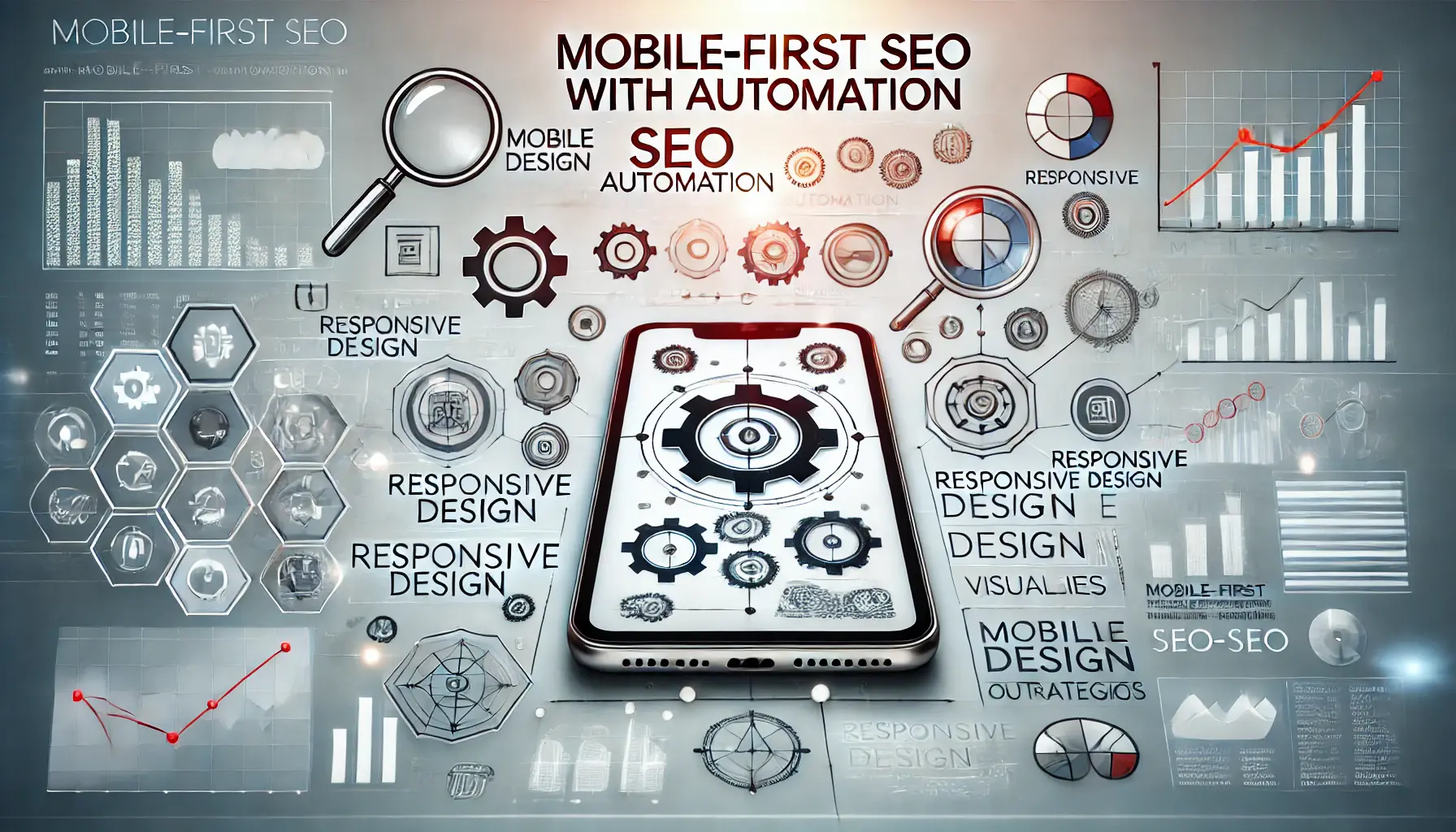
A visual representation of mobile-first SEO with automation, highlighting optimization processes for mobile platforms through responsive design and automation.
Mobile-First SEO with Automation
With the rise in mobile search, automating your SEO strategy for mobile-first indexing is crucial.
Since Google prioritizes mobile-friendly sites, automating mobile SEO practices will save time and improve your rankings.
Here’s how:
- Automated Mobile Optimization: Use tools like Google’s Mobile-Friendly Test or PageSpeed Insights to automatically verify and optimize your site for mobile platforms.
- Automated Mobile Usability Reports: Tools like Screaming Frog and SEMrush can generate automated reports identifying mobile usability issues, such as poor design or slow loading times.
- Automate Structured Data Implementation: Automate the use of structured data to help search engines better understand and rank your mobile content.

A visual representation of scaling automation for large websites, highlighting the expansion of automated SEO processes across many web pages.
Scaling Automation for Large Websites
Managing SEO automation for large websites with thousands of pages requires efficient scaling strategies.
Automation becomes essential for handling tasks such as keyword tracking, content updates, and technical audits.
Here’s how to automate SEO for large sites:
- Automated Site Audits: Tools like DeepCrawl and Sitebulb conduct comprehensive audits, checking for issues like broken links and duplicate content across large sites.
- Automated Content Updates: Use automation to track page performance and schedule content updates for pages that need optimization.
- Automated Recurring Reporting: Set up recurring reports to monitor your site’s SEO performance and identify areas for improvement automatically.
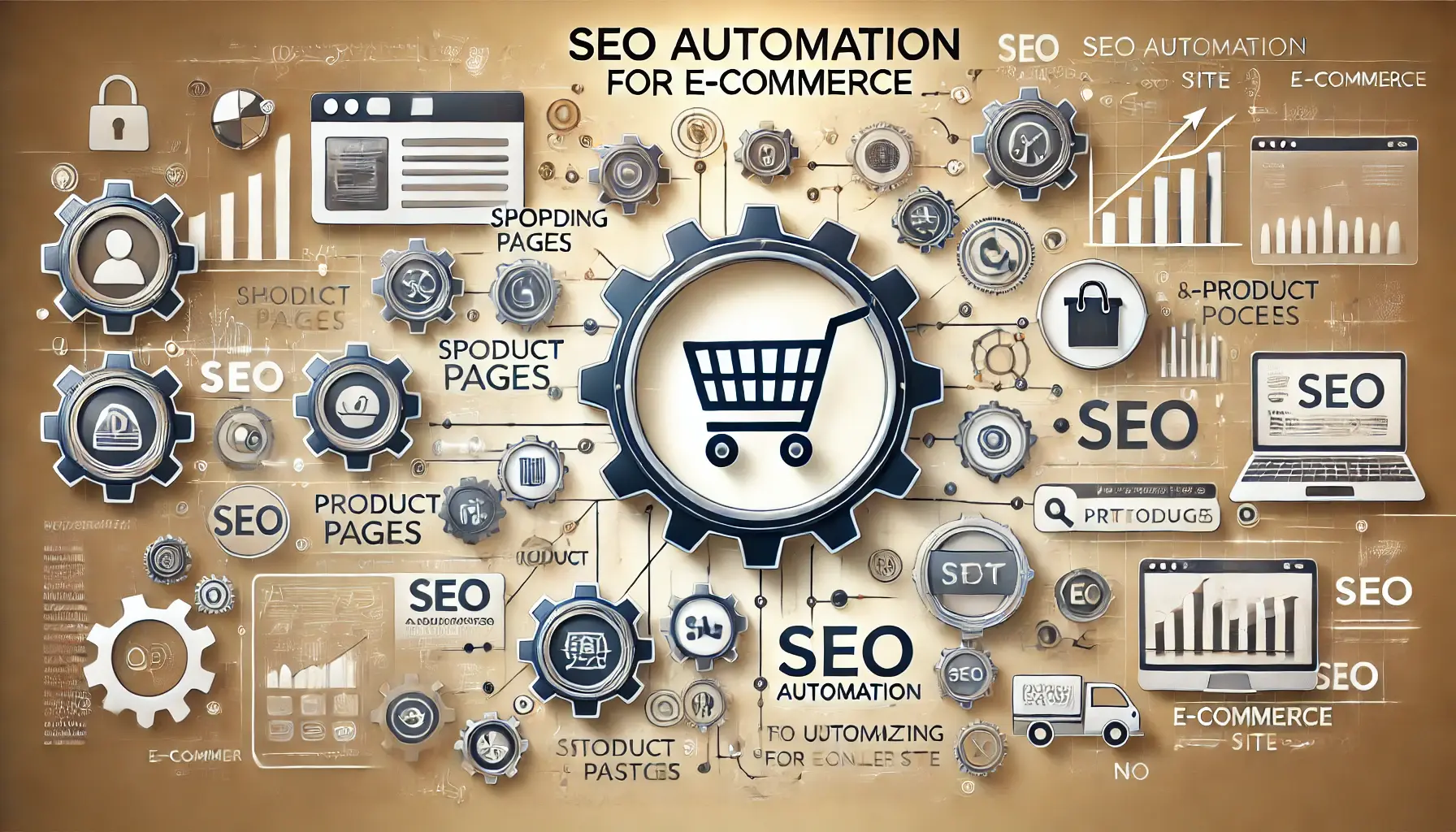
A visual representation of SEO automation for e-commerce, highlighting the automation processes that optimize online stores for search engines.
SEO Automation for E-commerce
E-commerce websites often have extensive product catalogs, making SEO more labor-intensive.
SEO automation can simplify tasks like product page optimization and inventory updates.
Here’s how:
- Product Page Optimization: Tools like SEMrush and Moz automate the process of optimizing titles, descriptions, and meta tags to improve rankings.
- Automated Inventory Management: Automation tools track product availability and update site content, preventing SEO issues caused by out-of-stock items.
- URL Automation: Managing URL structures and redirects for large e-commerce sites is made easier with automation, helping avoid duplicate content issues that can hurt SEO performance.
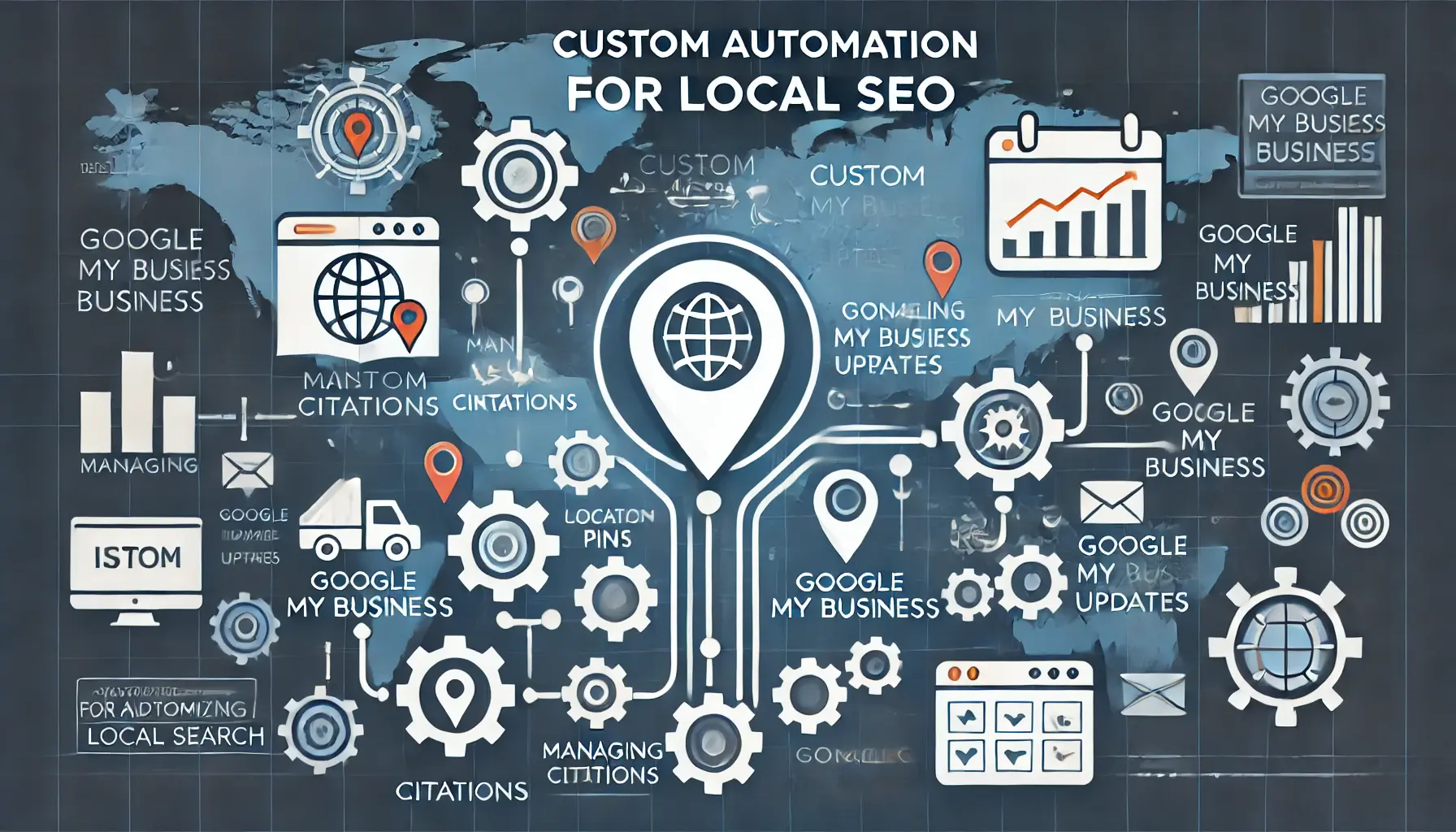
A visual representation of custom automation for local SEO, highlighting how automation tools optimize local search efforts for businesses.
Custom Automation for Local SEO
Local businesses rely heavily on their search rankings to attract customers.
SEO automation can be customized to meet your local SEO needs, helping to boost your business’s local presence.
Here are some ways to automate local SEO:
- Automated Google My Business Updates: Keep your Google My Business profile updated with the latest information, including services, promotions, and business hours, through automation.
- Localized Content Optimization: Automatically create and optimize content for specific local markets to increase relevance in local search results.
- Automated Citation Management: Use tools like Moz Local and BrightLocal to manage business citations across directories, ensuring consistency and improving local rankings.
Advanced strategies like AI and machine learning will further enhance SEO automation’s potential in 2024.

A visual representation of measuring success in SEO automation, highlighting how key performance indicators are tracked and analyzed.
PRO Tip: Measuring Success; Evaluating the Impact of SEO Automation
Automatically doing SEO automation is just the tip of the iceberg in optimizing your overall search engine strategy.
You need to check and balance whether automated SEO efforts are playing a role in reality or not.
Correctly monitoring the metrics will underline where SEO automation is working and if human intervention might still be needed.
Next, we’ll look at how to benchmark your SEO automation results and make meaningful improvements.
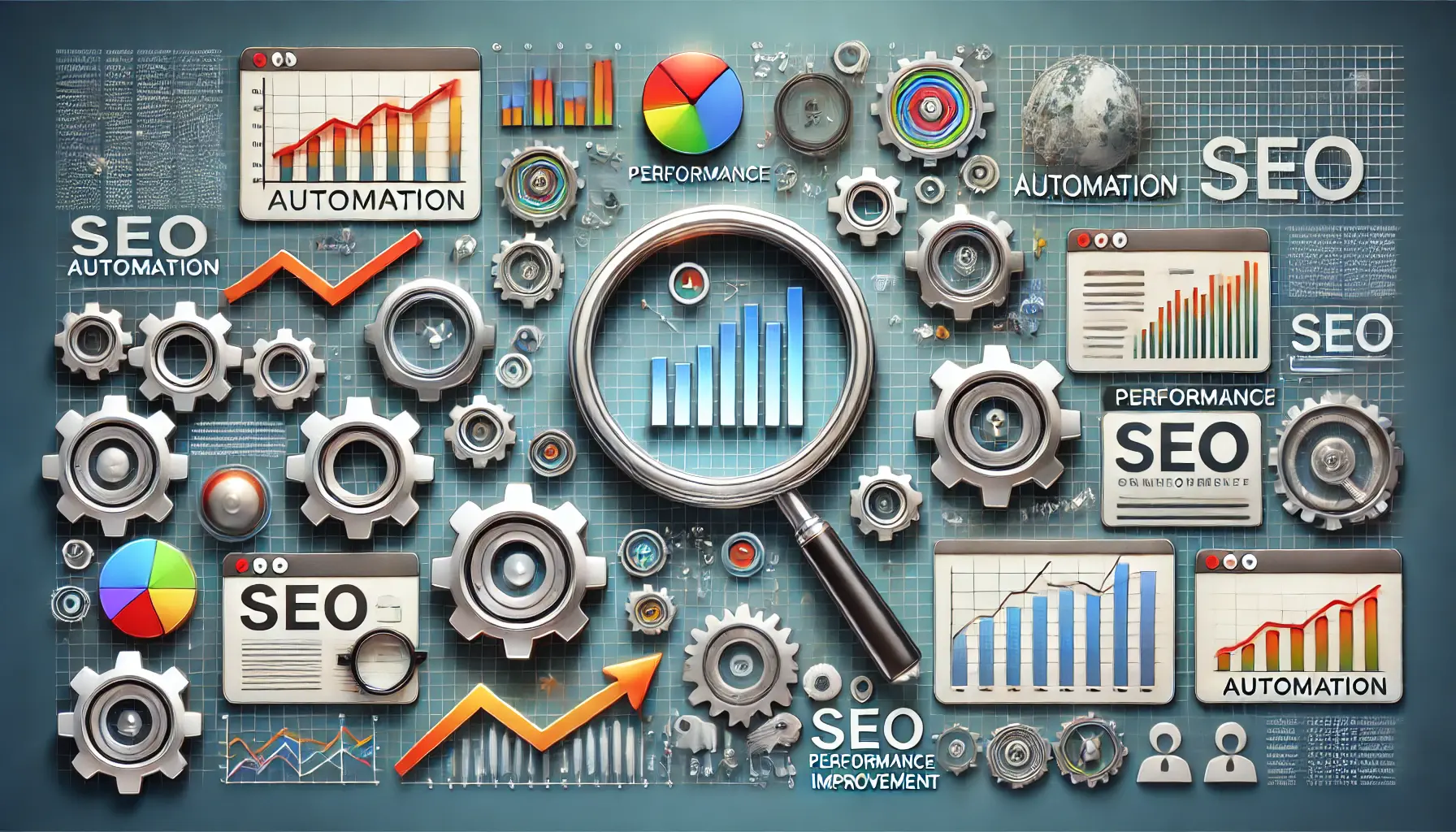
A visual representation of key indicators in SEO automation, highlighting performance tracking of traffic, rankings, and conversions through data-driven insights.
Key Indicators of SEO Automation
KPIs: You can’t measure the success of your SEO automation strategies without setting Key Performance Indicators.
The selected KPIsKey Performance Indicators, measurable values that demonstrate how effectively a company is achieving key business objectives. must always align with what your business is trying to achieve.
Some of the most utilized KPIs include:
- Organic Traffic: Monitor the growth in organic search traffic over time to gauge the benefits of your SEO automation efforts.
- Keyword Rankings: This shows the performance of your content in search results, enabling you to track the progress of both existing and new keywords.
- Conversion Rate: While traffic is good, conversions are better. Track how well organic traffic converts into leads, sales, or other goals.
- CTR (Click-Through Rate): This metric indicates how many users are clicking on your search engine listings, showing how well your titles and meta descriptions are optimized.
- Site Health: Running regular site audits to check for broken links, content duplication, and other technical issues helps ensure your SEO efforts remain effective.
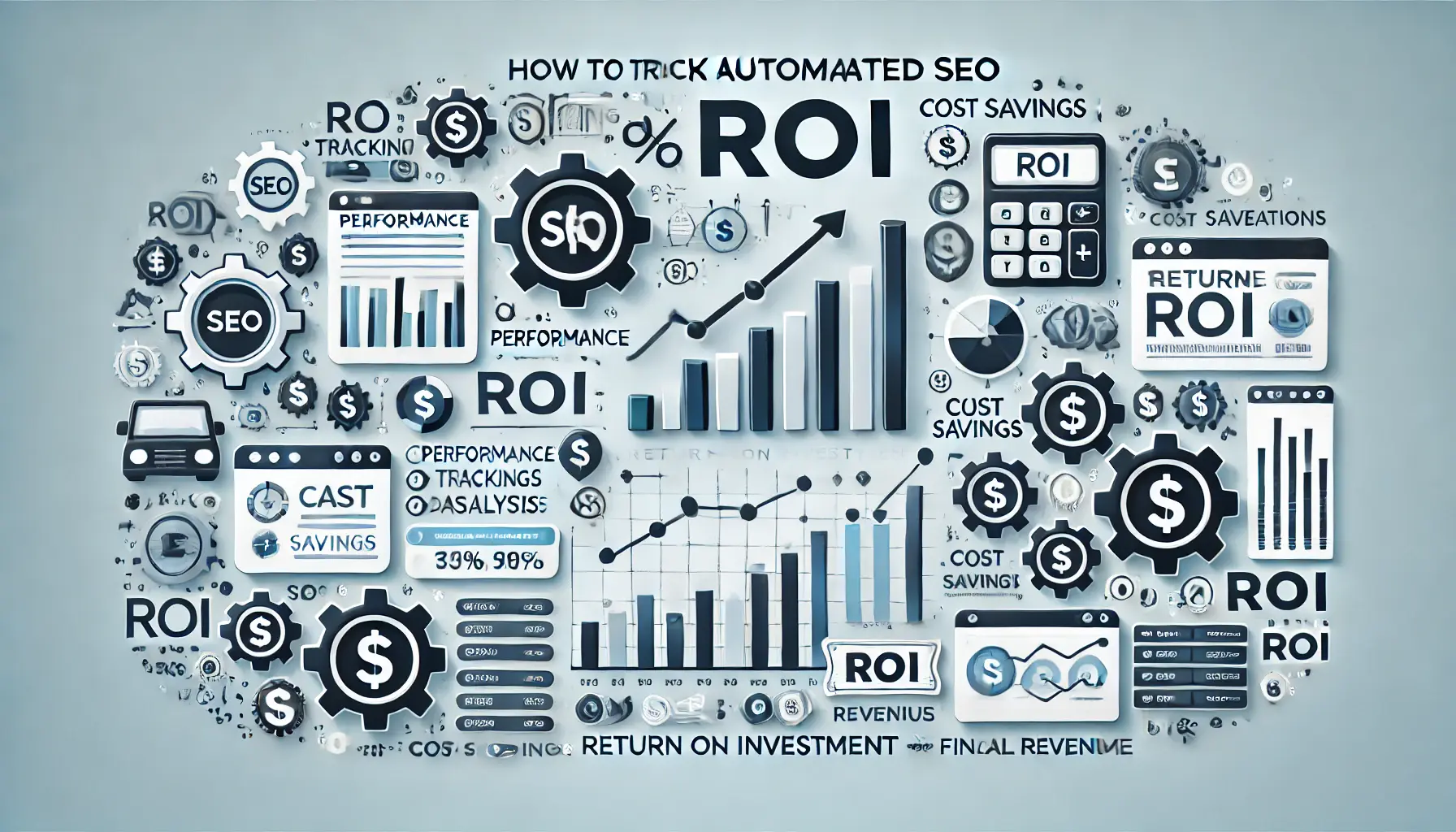
A visual representation of tracking ROI in SEO automation, highlighting the financial benefits and performance analysis.
How to Track Your Automated SEO ROI
Tracking the return on investment (ROI) of your SEO automation is crucial for understanding what tools and techniques are working best.
Here’s how to better track ROI:
- Cost of Tools: Keep track of the costs of the automation tools you’re investing in and compare them with the projected revenue gains from increased traffic and conversions.
- Time Savings: SEO automation saves time compared to manual processes. Calculate the time saved and multiply it by employee wages or opportunity costs.
- Revenue Growth: Measure the additional revenue driven by better rankings, traffic, and conversions compared to the cost of automation tools.
- Human Error Reduction: Automation reduces the likelihood of mistakes, such as incorrect keyword targeting or broken links, improving the overall efficiency of your SEO efforts.
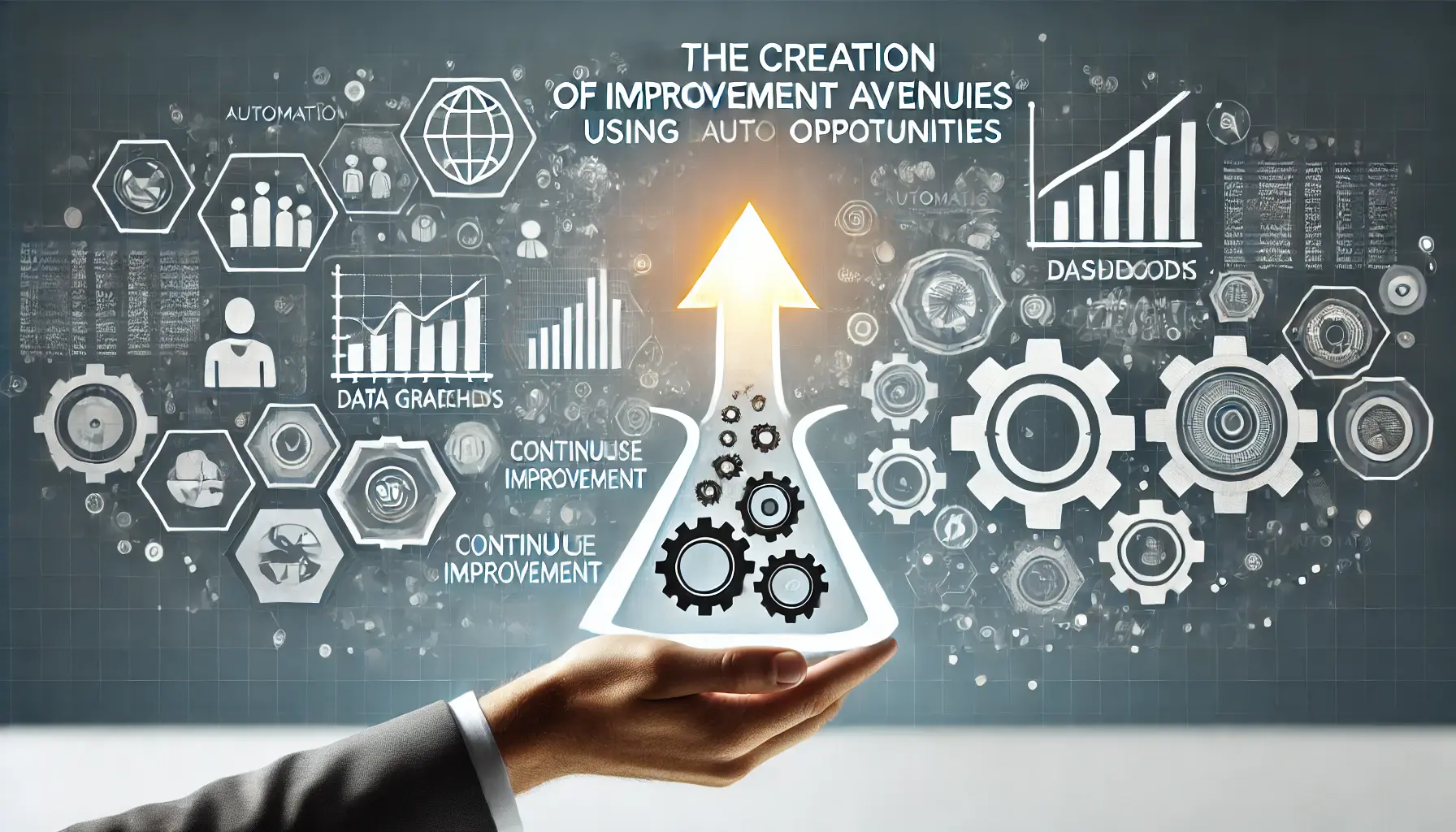
A visual representation of creating improvement avenues using automation data, highlighting data-driven growth and optimization strategies.
Creating Avenues for Improvement with Automation Data
Once your KPIs are in place and you have performance data, it’s time to identify areas for improvement.
SEO automation tools provide valuable insights to help you optimize your strategy:
- Audit Data: Regular site audits pinpoint issues like broken links, slow loading times, and neglected meta tags that could be hurting your SEO. Set up automated audits to catch these issues on a regular basis.
- Content Audit and Performance: Use tools like Surfer SEO or Clearscope to track how your content is performing in search engines. Identify low-performing content and refresh it to boost rankings.
- Keyword Gaps: Automated keyword tracking helps identify gaps in your strategy. Use this data to find new opportunities for keyword optimization.
- Backlink Analysis: Tools like Ahrefs and SEMrush automate backlink analysis, offering suggestions for gaining more high-quality backlinks.
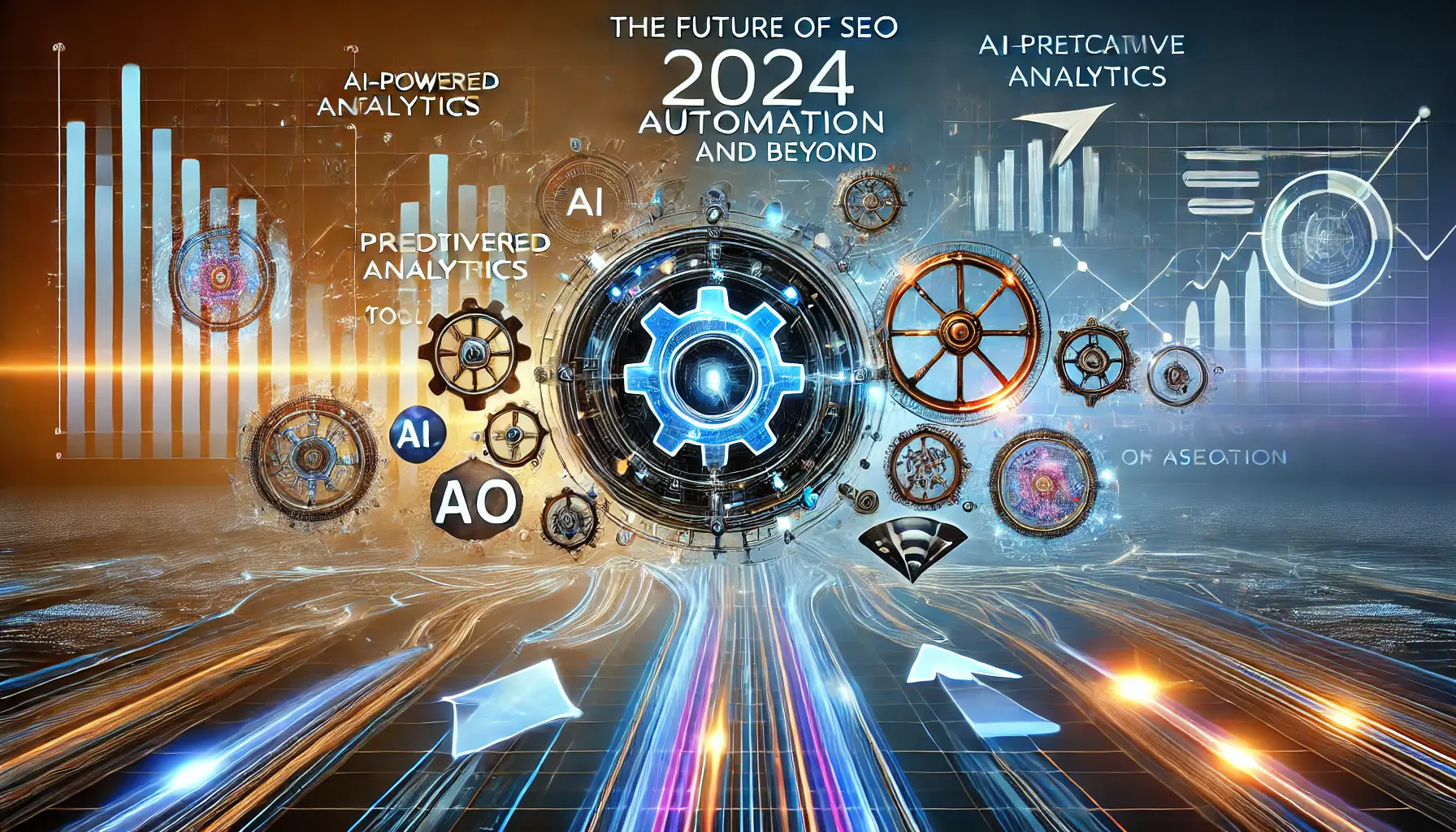
A visual representation of the future of SEO automation, highlighting AI-driven advancements and predictive analytics shaping SEO in 2024 and beyond.
The Future of SEO Automation in 2024 and Beyond
As SEO automation continues to evolve, it will become even more integral to search strategies.
Technologies like AI and machine learning will enhance automation tools, making SEO more efficient and data-driven.
Here are some trends to watch for:
- AI-Driven Keyword Research and Content Optimization: AI tools will continue to improve, offering deeper insights and more accurate content recommendations.
- Voice Search Optimization: As voice search becomes more popular, automation tools will adapt to optimize for conversational queries and natural language processing.
- Hyper-Personalization: SEO automation will enable businesses to serve highly personalized content based on user behavior, demographics, and search intent.
- Predictive SEO: Machine learning algorithms will predict future SEO trends, helping businesses stay ahead of algorithm updates and shifts in search behavior.
By adopting these trends and refining your SEO automation practices, you’ll be well-positioned for long-term success in the rapidly changing world of SEO.
Tracking key performance indicators such as organic traffic and keyword rankings is essential to evaluating SEO automation success.
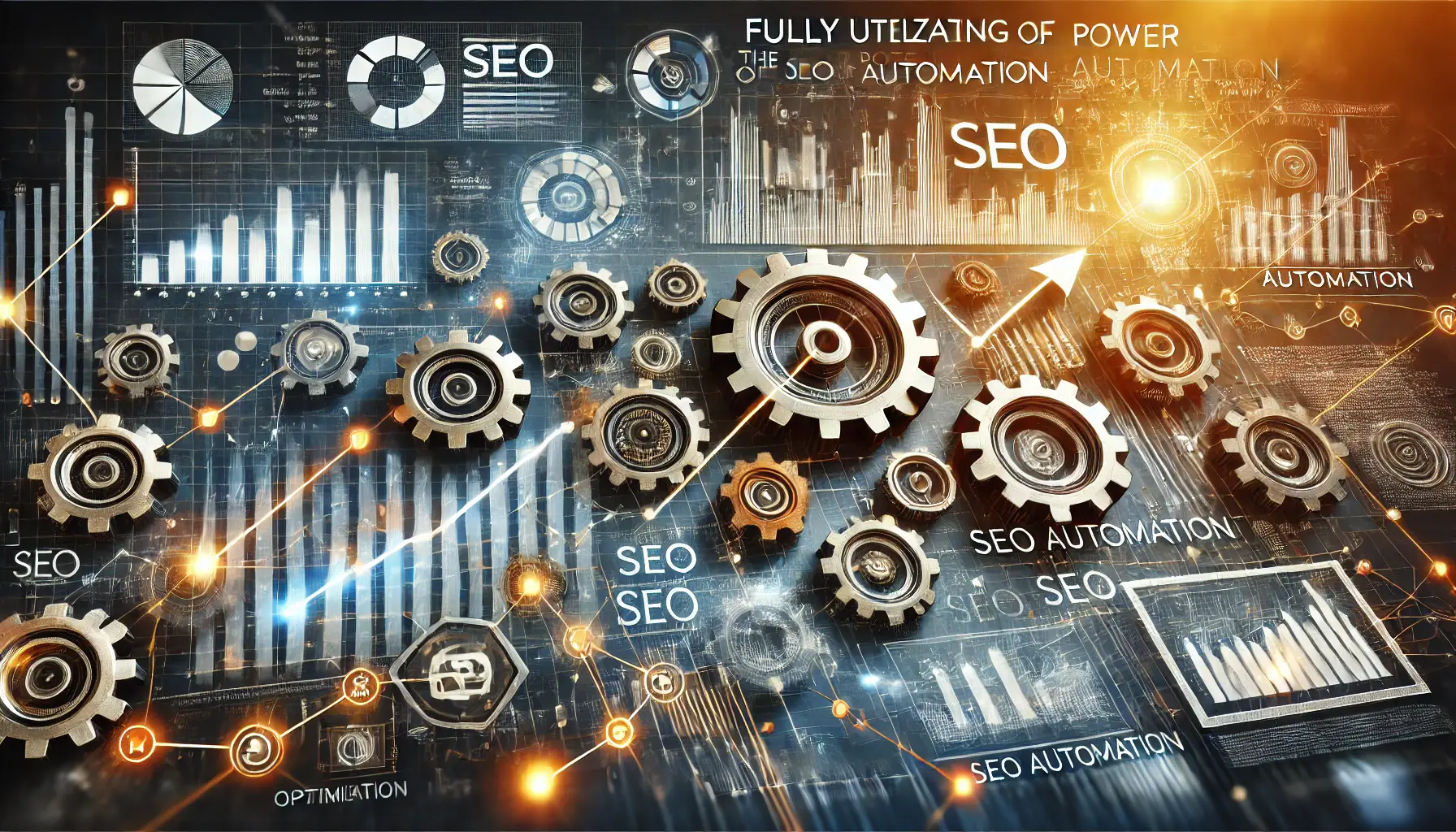
A visual representation of the full potential of SEO automation, highlighting seamless optimization and growth through automated processes.
Conclusion: How to Release the Full Power of SEO Automation
SEO automation is an integral part of every modern business today, helping optimize activities and time spent on SEO tasks, making the process easier and more precise.
As was discussed throughout this article, using legitimate SEO automation tools and methods can significantly enhance your performance in 2024 and beyond.
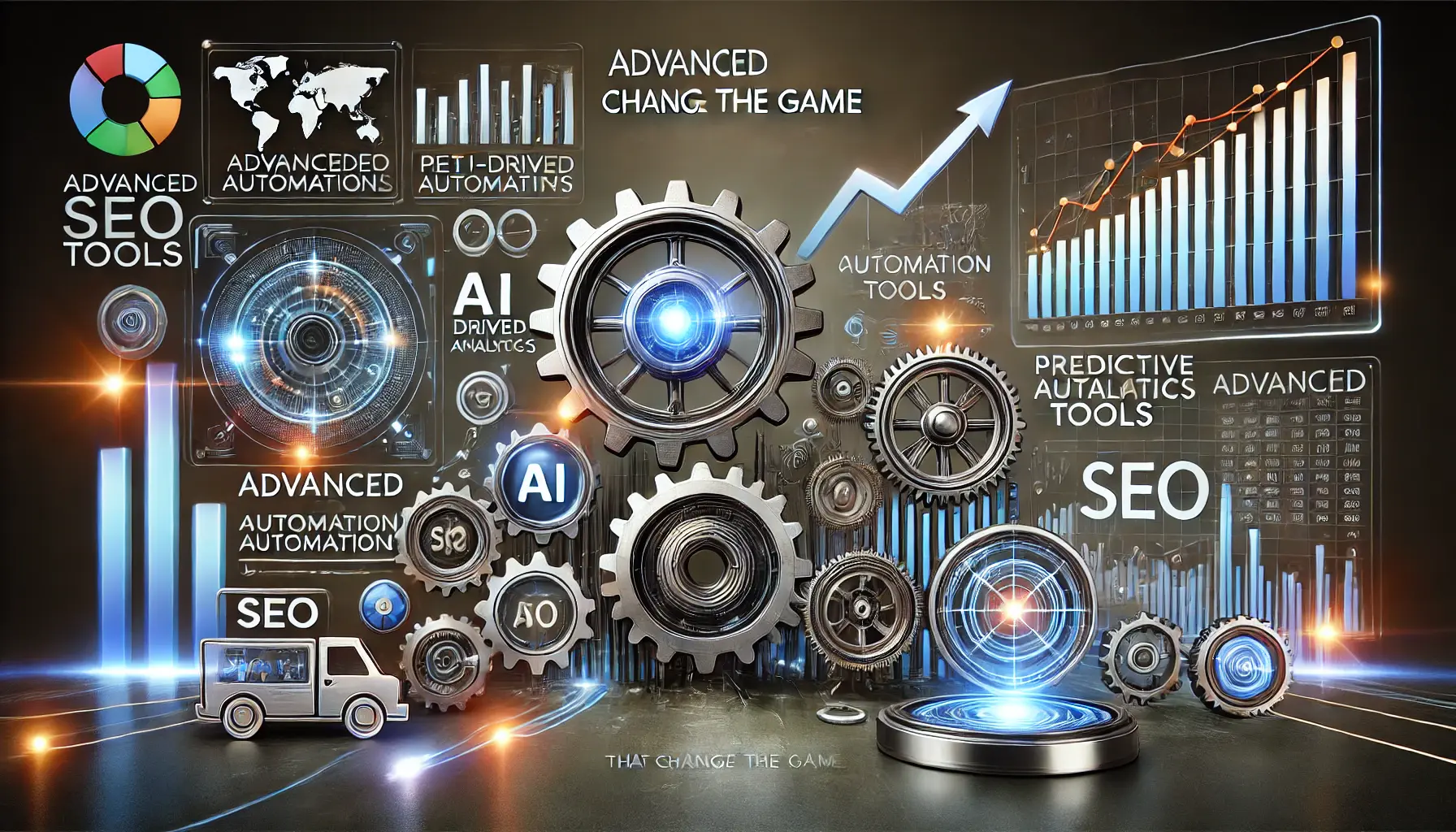
A visual representation of advanced SEO automation tools, highlighting their cutting-edge capabilities and transformative impact on SEO performance.
Advanced SEO Automation Tools Change the Game
AI, machine learning, and complex algorithms have completely transformed the world of SEO.
Modern SEO automation tools come with features that make it easier for businesses to automate keyword research, optimize content, and execute link-building techniques.
By incorporating such tools into your strategy, you can:
- Automate time-consuming tasks, including technical audits, reporting, and rank tracking.
- Use AI to predict trends and optimize your content with trending keywords.
- Improve user experience by ensuring your site is mobile-responsive and uses structured data correctly.

A visual representation of calibrating SEO automation effects, highlighting the fine-tuning and adjustment of strategies for optimal performance.
Calibrating the Effects of SEO Automation
The Key to SEO Automation Success: Measurement.
Set clear KPIs such as organic traffic, keyword rankings, conversion rates, and site health to ensure your efforts are measurable.
By measuring the ROI of your SEO automation tools, you’ll be confident that your investments are contributing to increased efficiency and performance.
Use the data from these automation tools to constantly optimize your SEO strategy.
Automation can help update low-performing content, fix broken links, and uncover new keyword opportunities.

A visual representation of the future of SEO automation, highlighting AI-driven tools, neural networks, and advanced analytics that shape the next generation of SEO strategies.
The Future of SEO Automation
Looking ahead, exciting trends such as AI-driven SEO, voice search optimization, and predictive SEO will shape the future of SEO automation.
These technologies will better equip businesses to handle ongoing changes in digital marketing.
Staying competitive will require adopting automation tools that bring personalization and efficiency into your workflow.
Staying on top of trends, refining your processes, and maintaining a forward-thinking approach are key to success.
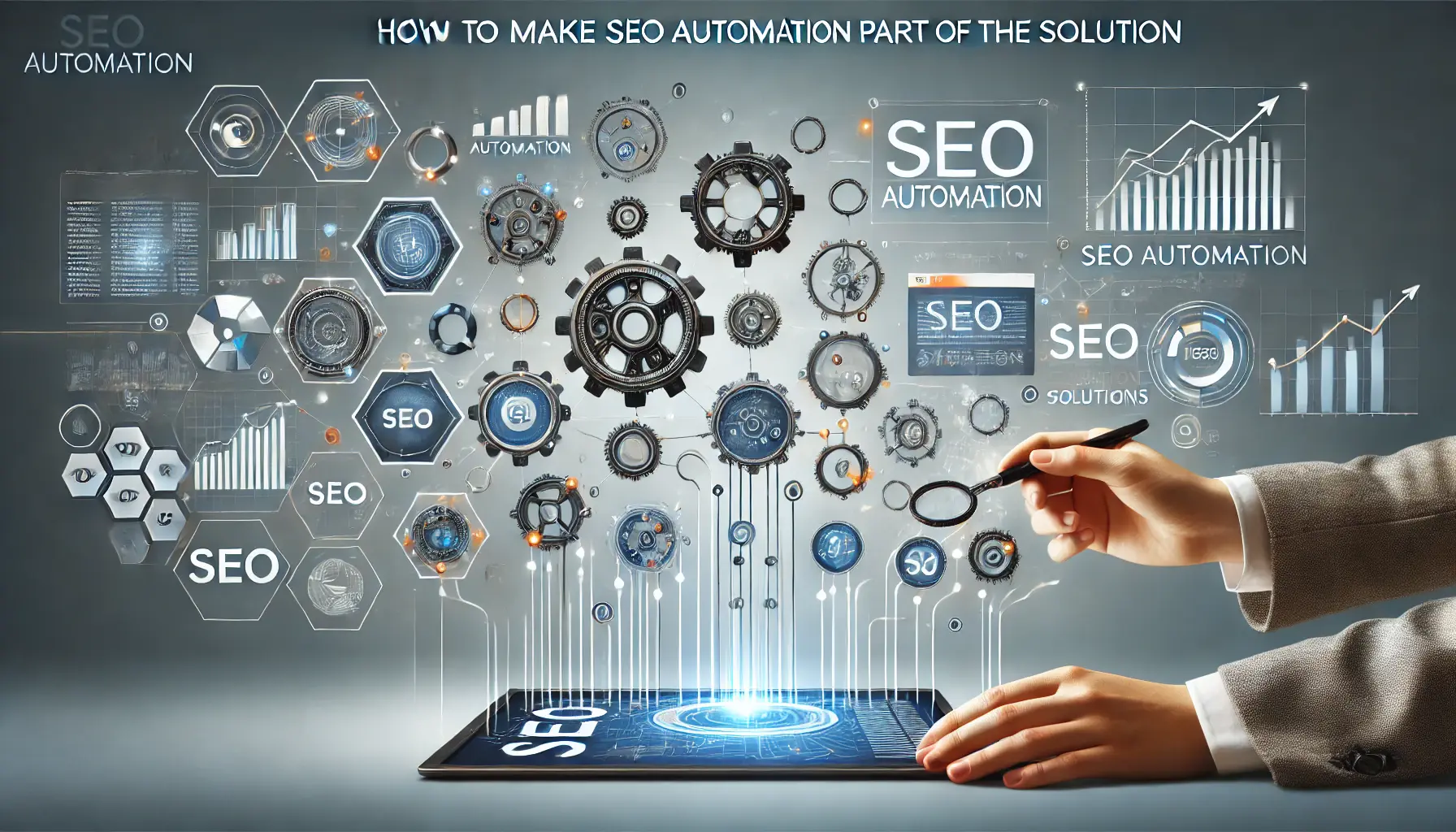
A visual representation of integrating SEO automation into strategies, highlighting the connection between automation tools and SEO success.
Conclusion: How to Make SEO Automation Part of the Solution
SEO automation has been an essential ally for many businesses.
Whether you’re setting up for mobile-first indexing, managing a large site, or creating an SEO strategy to drive local traffic, automation can be the difference between stagnation and growth.
The key is balancing automation with human involvement.
While automation can handle repetitive tasks efficiently, creativity and strategic thinking are still vital for success in SEO.
By leveraging both effectively, you can tap into the full potential of SEO automation and elevate your business to new heights.
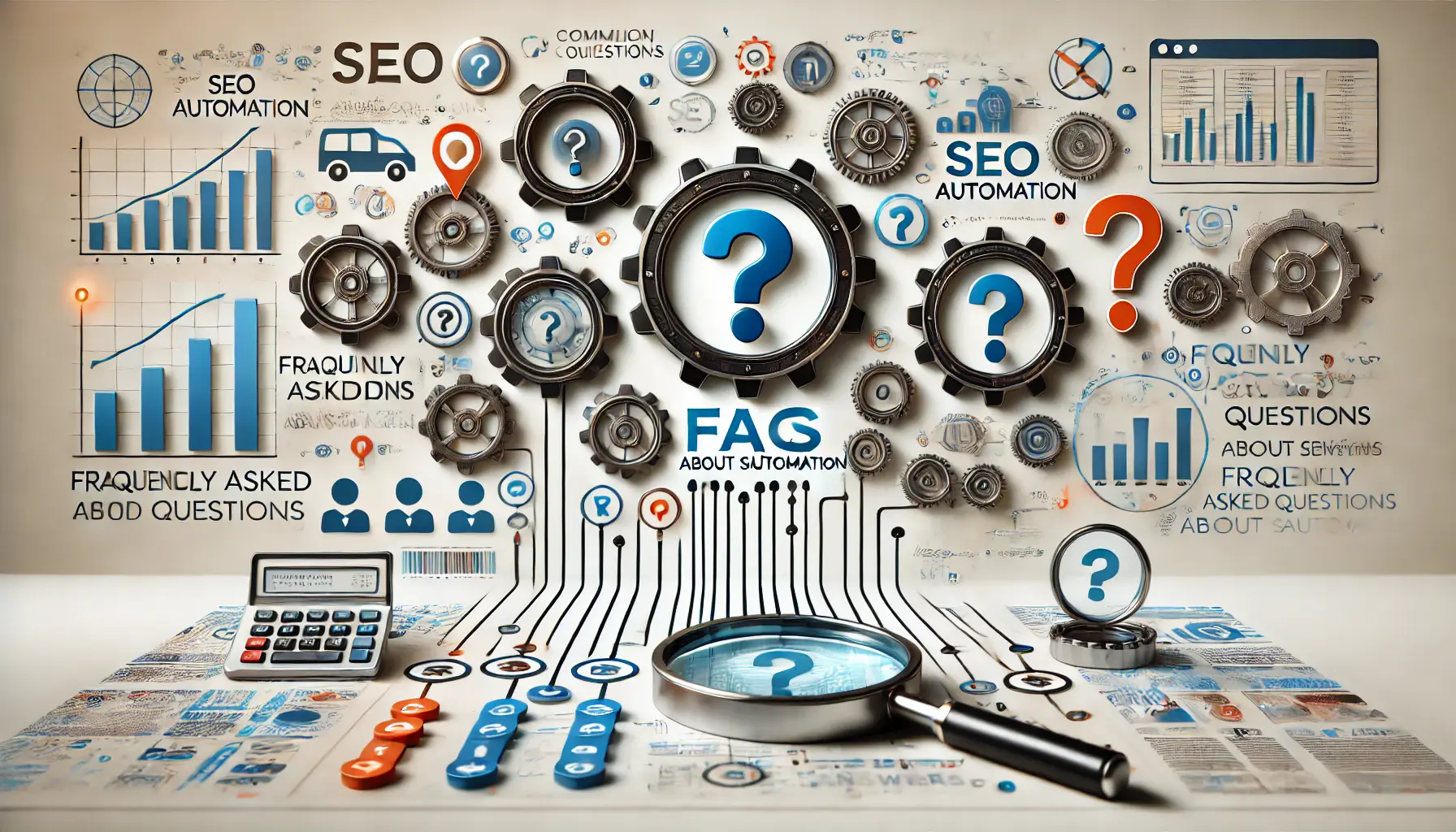
A visual representation of frequently asked questions about SEO automation, highlighting the flow of information and solutions.
Want your website to top Google search rankings? Leave the SEO to our professional agency!
FAQs About SEO Automation
Here are some of the most common questions about SEO automation and how it can improve your search engine optimization strategies.
These responses will help you better understand important concepts and provide insights into how SEO automation can be used effectively.
SEO automation uses software to automate repetitive tasks associated with an SEO campaign, such as keyword rank tracking, backlink monitoring, content optimization, and site speed enhancement, completing these tasks more quickly than manual efforts.
Yes, SEO automation can improve rankings by automating keyword research, technical audits, and content refreshes, allowing more time for strategic activities.
It ensures quicker implementation of SEO best practices, improving website rankings efficiently.
Many SEO tasks, including keyword tracking, on-page content optimization, rank tracking, link building, technical SEO audits, and reporting, can be automated using specialized SEO automation tools.
Popular SEO automation tools include SEMrush, Ahrefs, Surfer SEO, Screaming Frog, and Moz.
These tools offer advanced capabilities for keyword research, site audits, content optimization, and improving overall site performance.
Yes, SEO automation is beneficial for both large and small businesses by automating repetitive tasks, saving time, and enabling businesses to compete more effectively in organic search results.
Track SEO automation success by monitoring organic traffic, keyword rankings, conversion rates, and site health.
Measuring ROI helps ensure your automation tools are contributing to better performance and higher efficiency.
Yes, AI-driven SEO automation tools accelerate keyword research, content optimization, and technical audits by analyzing data trends and insights, improving your organic search strategy from end to end.












